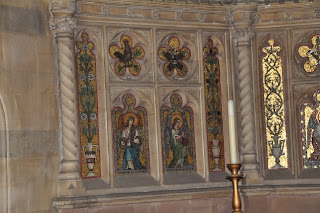Also known as the Windsor Parish Church, this house of worship was built by architect John Hollis in 1822 after the demolition of the original Norman church from the Middle Ages.
The interior has a hammerbeam roof, which is typical of English Gothic architecture that was popular between the twelfth and sixteenth centuries. The chancel was originally situated against the back wall of the church.
A new apse – designed in the Gothic Revival style – was added in 1870 by architect Samuel Sanders (S.S.) Teulon.
The new chancel wall is decorated with Salviati mosaics. Five sets of double panels sit directly under the same number of very tall, Gothic stained glass windows
Starting on the left, the first set of mosaics contains two angels – one is playing a violin, the other is banging a drum. Each is topped with a medallion that is in some way related to Christ's Passion. The first one shows a rooster – a symbol of Peter's denial of Christ, while the other is of crossed hatchets or battle axes – the emblem of St. John the Baptist.
The next set of mosaics depicts two angels kneeling in prayer. Their medallions show crossed pliers and a hammer, as well as an arrow, sponge, dice, and chalice motif.
The two mosaic compositions in the middle are of a lamb and pelican, respectively. The lamb, representing Christ and wearing a cruciform halo, carries a white flag with the red St. George cross, which is also the flag of England. The similarly haloed pelican, also symbolizing Christ and his sacrifice, is feeding its three young with drops of its own blood. The letters alpha and omega, the first and last letters of the Greek alphabet, decorate the medallions above the animals and indicate that Christ is both the beginning and the end.
The mosaics on the right of the central panel also show two angels kneeling in prayer. The symbols above them are of crossed reeds, a column and Veronica's veil with Christ's imprinted image, as well as the three nails of the cross and the crown of thorns.
Finally, the mosaic set to the far right contains one angel playing a trumpet and the other a hand-held organ. Above them is a ladder with a robe, and a crossed spear, sponge, reed
and banner with the letters “INRI” meaning “Jesus of Nazareth, King of
Jews.”
All of the mosaic sets are flanked by two additional, narrow mosaics showing various symbolic flowers growing out of decorative urns.
Sources:
Kovach, Rita S. "The Anglo-Catholic Revival's Contribution to the Resurgence of the Venetian Mosaic Enamel Industry." Proquest. Graduate Thesis. 2012. 39-40.
Jena76's flickr Photostream
Earth in Pictures









No comments:
Post a Comment